-
Special Issue

-
Protective Facility Standard and Blast-proof Facility Design Standards
방호시설기준 및 방폭시설설계기준
-
Hong-Gun Park, Jang-Woon Baek
박홍근, 백장운
- With the increasing threat of localized conflicts and full-scale wars due to global geopolitical tensions—including the ongoing wars in Ukraine and the …
우크라이나 및 중동 전쟁, 북한의 핵 위협, 중국의 팽창 정책 등으로 인해 전 세계적으로 지정학적 긴장이 고조되면서 국지전 및 전면전에 대한 위협이 …
- With the increasing threat of localized conflicts and full-scale wars due to global geopolitical tensions—including the ongoing wars in Ukraine and the Middle East, North Korea’s nuclear threats, and China's expansionist policies—the importance of protective facilities for civilians and public infrastructure has become paramount. In South Korea, where over half of the population resides near the demilitarized zone, civil protection during wartime is a critical national concern. While there are over 14,000 designated civilian shelters, most lack sufficient protective capabilities, particularly against nuclear or high-explosive attacks. This study introduces the newly developed Standards for Protective Facilities and Explosion-Proof Facility Design Standards, published by the Korean Society of Protective Facilities Engineering. The standards aim to provide unified guidelines for designing, assessing, and upgrading both new and existing civil and public protective structures. The paper outlines structural performance levels required for various protection grades, explains simplified blast load models, and details the design procedures for reinforced concrete protective structures under explosive loads. It also includes practical classification criteria for blast damage levels and introduces methods for pressure-time response analysis, dynamic load amplification, and structural detailing strategies to ensure occupant safety and functionality under attack scenarios. These standards are expected to serve as essential tools in enhancing national civil defense infrastructure in a cost-effective and scalable manner.
- COLLAPSE
우크라이나 및 중동 전쟁, 북한의 핵 위협, 중국의 팽창 정책 등으로 인해 전 세계적으로 지정학적 긴장이 고조되면서 국지전 및 전면전에 대한 위협이 증가하고 있다. 이러한 상황 속에서 민간인과 공공 인프라를 위한 방호시설의 중요성이 더욱 부각되고 있다. 특히 인구의 절반 이상이 비무장지대 인근 수도권에 밀집해 있는 대한민국의 경우, 전시 민간 보호는 국가적 과제로 대두되고 있다. 현재 국내에 지정된 민간 대피시설은 14,000여 개에 달하지만, 대부분이 핵이나 고성능 폭발물에 대한 방호능력을 갖추지 못한 실정이다. 본 논문에서는 (사)한국방호시설학회에서 제정한 「방호시설기준」 및 「방폭시설설계기준」을 소개하고자 한다. 이 기준은 민간 및 공공의 신축·기존 구조물에 대한 통합적 설계·평가 및 보강 지침을 제공함으로써 실질적인 방호능력 향상을 목적으로 한다. 본 논문에서는 방호등급별 구조 성능 요구사항, 폭발하중의 간단화 모델, 철근콘크리트 방호구조의 설계 절차를 중심으로 기술하고 있으며, 손상 수준의 분류 체계, 폭압-시간 응답 해석, 동적증폭계수(DLF)의 적용, 그리고 구조 상세 설계방안을 포함한다. 이 기준은 비용 효율적이며 확장 가능한 방호 인프라 구축을 위한 실질적 도구로 활용될 수 있을 것으로 기대된다.
-
Protective Facility Standard and Blast-proof Facility Design Standards
-
Special Issue
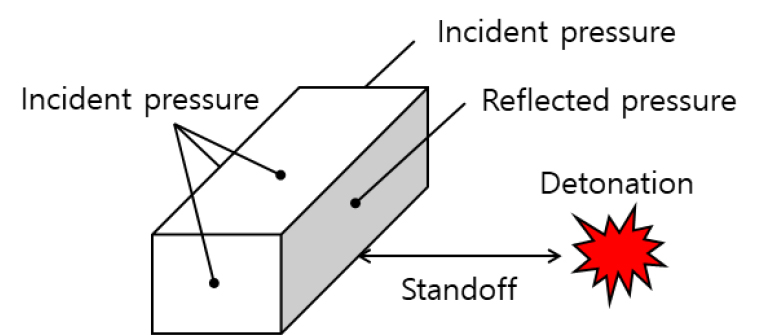
-
Estimation of Blast Pressure for Explosion Proof Facility Design
방폭시설의 폭압설계하중 산정법
-
Hyeon-Jong Hwang, Sangwoo Park, Jang-Woon Baek
황현종, 박상우, 백장운
- With increasing threats from wars, terrorism, and industrial explosions, the risk of blast loads on civilian structures is rising. However, current Korean …
전쟁, 테러, 산업시설 폭발 등의 위협 증가로 민간 건축물에 대한 폭발하중의 위험성이 커지고 있다. 그러나 국내 건축구조설계기준은 일반 건축물에 폭발하중을 고려하지 않는다. …
- With increasing threats from wars, terrorism, and industrial explosions, the risk of blast loads on civilian structures is rising. However, current Korean building codes do not account for explosion loads in general design. To address this, the Korea Protective Facilities Institute (KPFI) proposed design standards incorporating simplified blast load estimation methods. This study presents two models—the equivalent triangular and bilinear function models—for calculating pressure-time relationships on front, side, roof, and rear walls of above-ground structures. An example case demonstrates the application of these models to derive blast design loads for each structural component, offering a practical guideline for blast-resistant structural design.
- COLLAPSE
전쟁, 테러, 산업시설 폭발 등의 위협 증가로 민간 건축물에 대한 폭발하중의 위험성이 커지고 있다. 그러나 국내 건축구조설계기준은 일반 건축물에 폭발하중을 고려하지 않는다. 이에 한국방호시설학회(KPFI)는 방폭시설설계기준을 제정하고, 폭발하중 산정의 단순화를 위한 등가삼각형 모델과 이선형함수 모델을 제시하였다. 본 연구는 개구부 없는 지상 구조물의 전면, 측면, 지붕, 후면 벽체에 작용하는 폭발하중을 계산하는 방법을 소개하고, 예제 구조물에 이를 적용하여 구조요소별 폭압설계하중을 도출하였다. 제시된 모델은 방호 구조물 설계에 실용적인 지침을 제공한다.
-
Estimation of Blast Pressure for Explosion Proof Facility Design
-
Special Issue
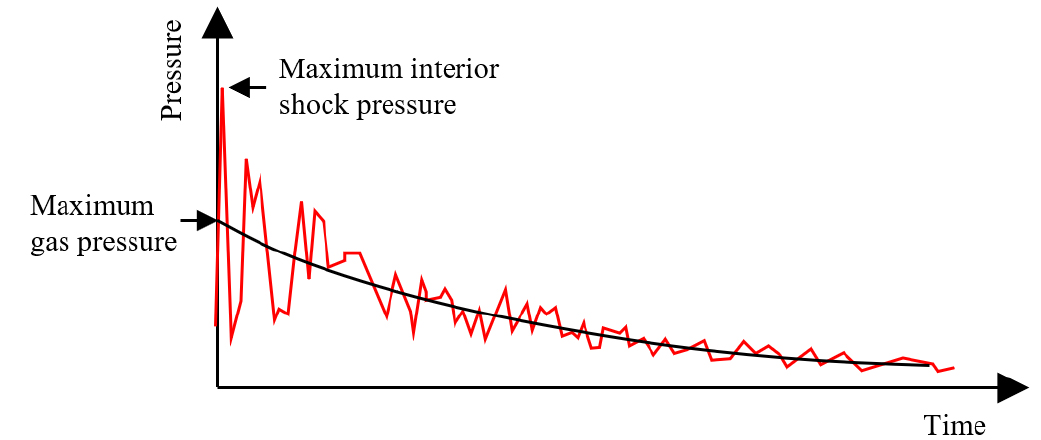
-
Protective Design Concept and Calculation of Blast Load Estimation for Internal Explosion
내부 폭발에 대한 방호설계 개념 및 폭발하중 산정
-
Sangwoo Park, Hyeon-Jong Hwang, Jang-Woon Baek, Sangyoung Han, Kukjoo Kim
박상우, 황현종, 백장운, 한상영, 김국주
- Recently, the number of high-energy industrial facility installations has been increasing, leading to a growing demand for protective design against internal explosions. …
최근 고에너지 산업 시설의 설치 사례가 늘어남에 따라 내부 폭발에 대한 방호 설계 수요 역시 증가하고 있다. 내부 폭발에 대한 방호 설계는 …
- Recently, the number of high-energy industrial facility installations has been increasing, leading to a growing demand for protective design against internal explosions. Protective design for internal explosions requires a different approach compared to that for external explosions. First, when an explosion occurs inside a facility, multiple reflections between structural components result in increased peak overpressure. Moreover, due to unvented gases, internal pressure is sustained, which extends the duration of the blast load. Second, unlike typical high-explosive detonations, internal explosions involve a wide range of scenarios depending on factors such as the concentration of flammable materials, ignition sources, and surrounding environmental conditions, etc. These factors must be taken into account when determining the blast load. Finally, the primary protection target shifts from personnel and assets on the opposite side of the structure to those located outside the facility, who may be affected by pressure leaking from the internal explosion. Among these different approaches, this study introduces a method for determining the explosion design load caused by internal explosions. In addition, practical examples based on UFC 3-340-02 and ASCE guidelines are presented to assist engineers in determining internal explosion design loads in simple cases.
- COLLAPSE
최근 고에너지 산업 시설의 설치 사례가 늘어남에 따라 내부 폭발에 대한 방호 설계 수요 역시 증가하고 있다. 내부 폭발에 대한 방호 설계는 외부 폭발에 대한 방호 설계와는 다른 접근 방식을 필요로 한다. 첫째, 시설 내부에서 폭발이 발생하면 구조 요소 간 다중 반사가 발생하여 최대 과압이 증가한다. 또한, 배출되지 않은 가스로 인해 내부 압력이 유지되면서 폭발 하중 지속 시간이 길어진다. 둘째, 일반적인 고밀도 폭약과는 다르게 산업시설에서의 폭발은 가연성 물질의 농도, 발화원, 주변 환경 조건 등 다양한 요인에 따라 다양한 시나리오를 수반한다. 따라서 폭발 하중을 결정할 때 이러한 요인들을 반드시 고려해야 한다. 마지막으로, 주요 방호 대상은 구조물 반대편의 인명 및 자산이 아닌 내부 폭발로 인한 압력의 누출에 대한 외부의 인명 및 자산으로 변경된다. 이러한 다양한 접근 방식 중, 본 연구에서는 내부 폭발로 인한 폭발 설계 하중을 결정하는 방법을 소개하였다. 또한, UFC 3-340-02와 ASCE 설계 기준에 따른 예제를 제시하여 실무자가 내부 폭발 설계 하중을 결정하는 데 도움이 될 수 있도록 하였다.
-
Protective Design Concept and Calculation of Blast Load Estimation for Internal Explosion
-
Special Issue

-
Design of Reinforced Concrete Walls in Civil Protective Facility according to Blast Design Code
방폭설계기준에 따른 철근콘크리트 벽식 방호시설의 설계
-
Sung-Hyun Kim, Su-Min Kang
김성현, 강수민
- This study introduced a design example of a reinforced concrete walls in civil protective facility. The target structure was a box shaped …
본 논문에서는 철근콘크리트 벽식 민간 방호시설의 설계 예제를 소개하였다. 대상 구조물은 단층의 벽식 구조 방호시설로서, 민간 시설임을 고려하여 폭발 거리 15 m의 …
- This study introduced a design example of a reinforced concrete walls in civil protective facility. The target structure was a box shaped single-story wall structure. Addressing the civil facility, the blast load was calculated assuming a long-distance explosion of 15 m. The equivalent static blast pressure was calculated by considering the natural period corresponding to the local vibration mode of the wall. The the required forces of the walls by the explosion was evaluated based on the linear elastic analysis. Based on the structural analysis results, the wall was designed according to the design standards for blast-proof structures of the Korean Protective Facility Institutes (KPFI). Based on the design results, a design recommendation to secure safety and economy of RC protective facilities was discussed.
- COLLAPSE
본 논문에서는 철근콘크리트 벽식 민간 방호시설의 설계 예제를 소개하였다. 대상 구조물은 단층의 벽식 구조 방호시설로서, 민간 시설임을 고려하여 폭발 거리 15 m의 원거리 폭발을 가정하여 폭발하중을 산정하였다. 벽체의 국부 진동 모드에 해당하는 고유주기를 고려하여 등가정적폭압을 산정하고, 선형 탄성해석을 바탕으로 폭발에 의한 벽체의 요구하중을 평가하였다. 구조해석결과에 기반하여 한국방호시설학회의 방폭시설설계기준에 따라 벽체를 설계하였다. 설계결과를 바탕으로 RC 벽식 방호시설의 안전성과 경제성을 동시에 확보하기 위한 방안을 논의하였다.
-
Design of Reinforced Concrete Walls in Civil Protective Facility according to Blast Design Code
-
Special Issue
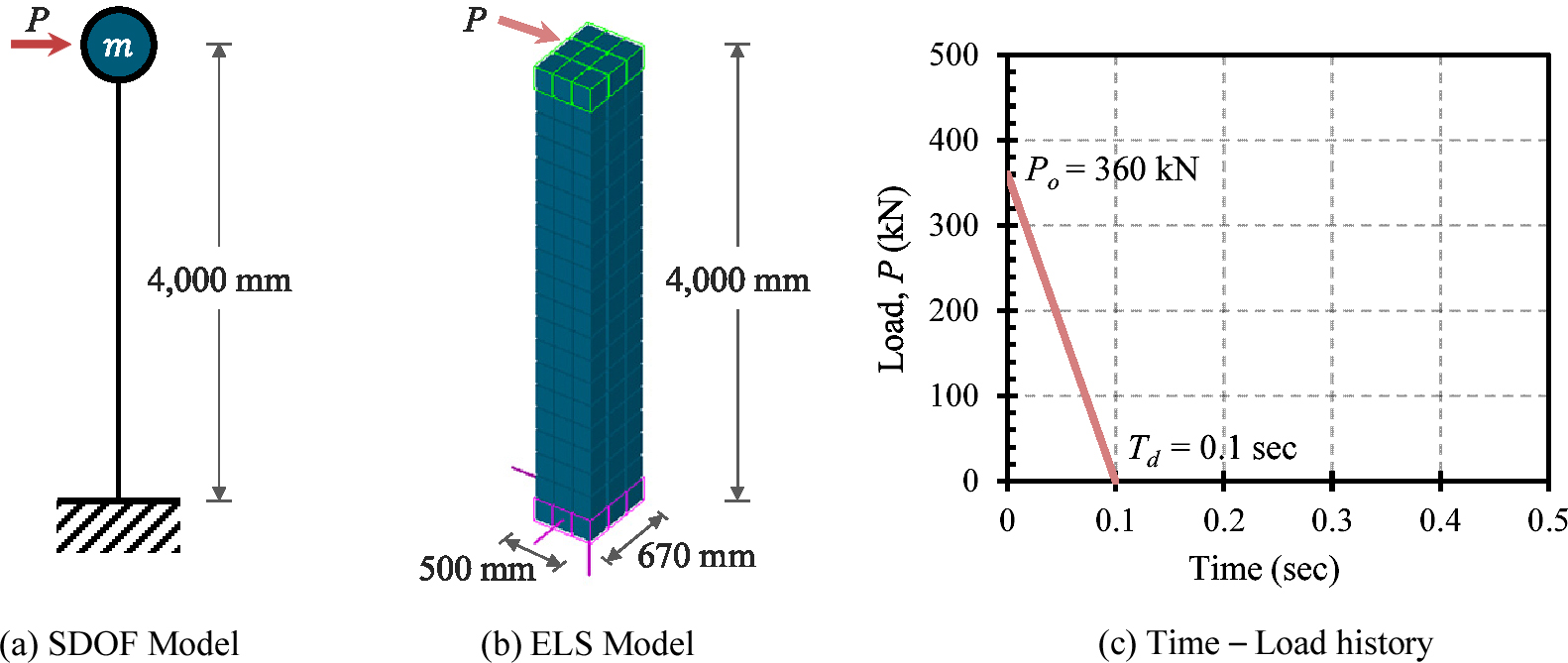
-
Nonlinear Dynamic Analysis for Blast-Resistant Design of Building Structures
비선형 동적 해석을 통한 건축 구조물의 방폭 설계 검증 연구
-
Sooyeon Jeong, Ji-Eun Roh, Sang-hyun Lee
정수연, 노지은, 이상현
- This study evaluated the blast response of reinforced concrete (RC) structures using both UFC-based equivalent static analysis (via Midas Gen) and nonlinear …
본 연구는 철근콘크리트 구조물의 폭발하중에 대한 구조 응답을 검토하기 위해, 단자유도(SDOF) 모델과 민간시설 RC 벽체를 대상으로 등가정적해석(UFC 기준 기반 Midas Gen)과 비선형 …
- This study evaluated the blast response of reinforced concrete (RC) structures using both UFC-based equivalent static analysis (via Midas Gen) and nonlinear dynamic analysis (via ELS) for SDOF models and RC walls. In the SDOF analysis, both methods showed similar results, suggesting that UFC-based analysis is practical for simple systems. For RC walls, the UFC method underestimated blast loads at higher ductility levels, but still produced higher member forces due to conservative assumptions. Nonlinear analysis confirmed that structural performance requirements were met, with most reinforcement remaining elastic. These results indicate that while UFC analysis is useful for initial design, nonlinear dynamic analysis is necessary for accurate damage assessment and more economical design.
- COLLAPSE
본 연구는 철근콘크리트 구조물의 폭발하중에 대한 구조 응답을 검토하기 위해, 단자유도(SDOF) 모델과 민간시설 RC 벽체를 대상으로 등가정적해석(UFC 기준 기반 Midas Gen)과 비선형 동적해석(ELS)을 수행하였다. 단자유도 모델에서는 두 해석 간 최대변형 및 도달시간의 차이가 크지 않았으며, UFC 해석이 실무 적용에 있어 적절한 수준의 결과를 제공함을 확인하였다. 한편, RC 벽체의 해석에서는 연성도 증가에 따라 UFC 해석이 하중을 과소평가하는 경향을 보였으며, 이에 따라 고연성 조건에서는 시간 이력 기반 해석의 병행이 요구되지만, 실제 해석 결과 비교시 등가정적해석 모델에서 부재력이 크게 산정되었다. 이는 균열 강성, 하중-질량 계수, 실제 파괴모드에 따른 하중의 분포 양상의 차이에서 기인한 것으로 판단된다. 전체적으로 비선형 해석 결과는 구조물의 요구성능을 충족하였고, 대부분의 철근도 탄성범위 내에서 거동하였다. 이상의 분석을 통해 UFC 기반 해석은 실용적인 초기 설계 도구로서 활용 가능하지만, 파괴 양상 상세나 경제적인 설계를 위해서는 비선형 해석이 필요함을 확인하였다.
-
Nonlinear Dynamic Analysis for Blast-Resistant Design of Building Structures
-
Special Issue
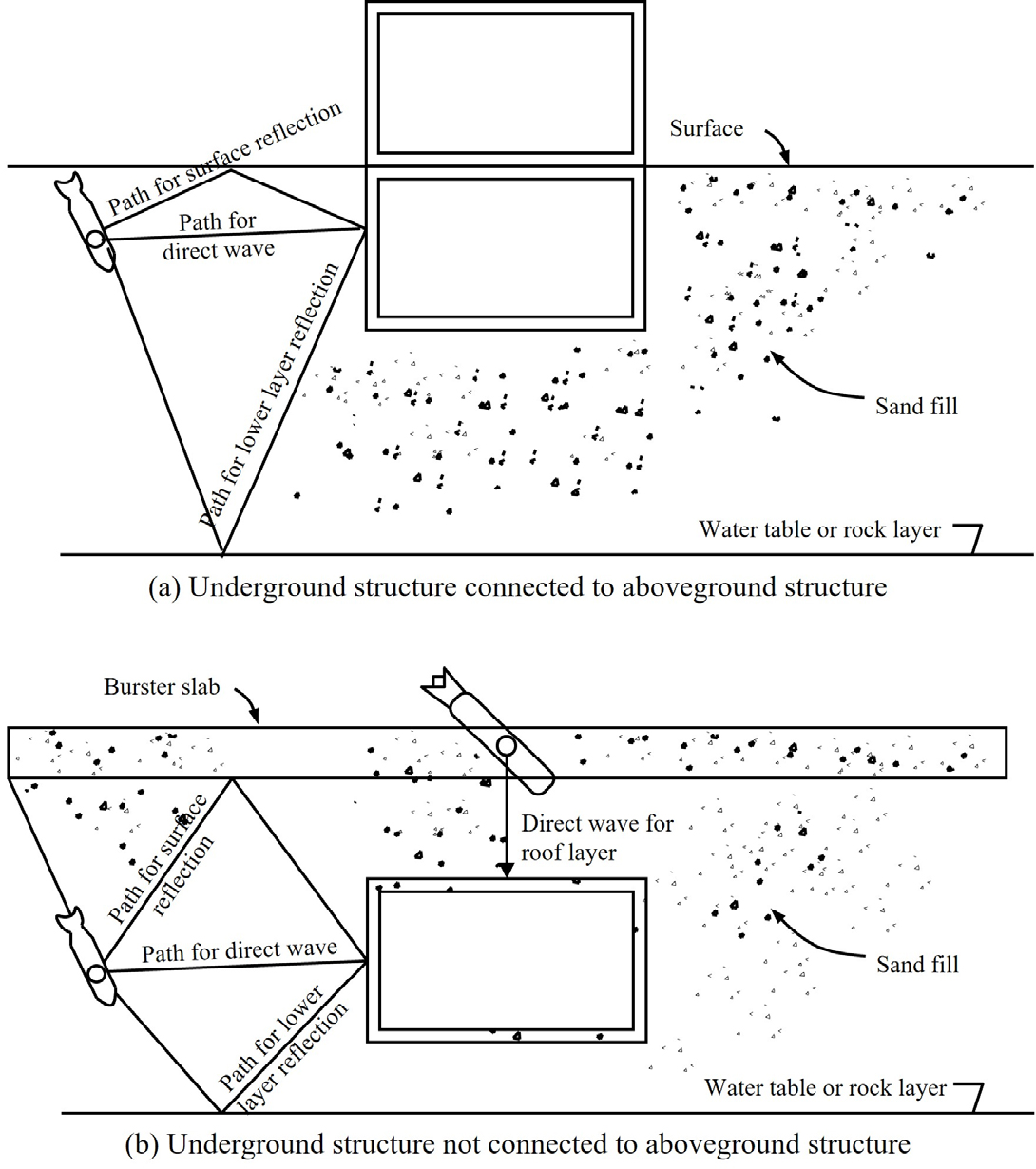
-
Explosion Load Estimation for Underground Structures in Protective Facility
방폭시설 지하구조의 폭발하중 산정
-
Jin-Young Park, Hong-Gun Park
박진영, 박홍근
- The growing threat of nuclear weapons, global regional conflicts, and the expansion of high-energy industrial facilities due to industrial development and new …
최근 북핵 위협의 증가, 전 세계적인 국지전 발생, 그리고 산업 발전 및 신에너지 개발로 인해 고에너지 산업시설의 구축이 확대되면서 방호시설의 필요성이 커지고 …
- The growing threat of nuclear weapons, global regional conflicts, and the expansion of high-energy industrial facilities due to industrial development and new energy advancements have increased the demand for protective structures. Particularly, the importance of nuclear and radiation protection has highlighted underground structures as effective defensive facilities, utilizing soil as an additional shield. Consequently, the Explosive Protection Facility Design Standards regulate the design of underground structures for blast protection, and the corresponding guidelines provide related examples. This paper outlines key considerations in underground structure blast protection design, including general aspects, shock pressure, and design load calculation methods. Through this approach, applying the blast load calculation method based on soil type and pressure wave propagation will enable safer and more efficient underground structural designs.
- COLLAPSE
최근 북핵 위협의 증가, 전 세계적인 국지전 발생, 그리고 산업 발전 및 신에너지 개발로 인해 고에너지 산업시설의 구축이 확대되면서 방호시설의 필요성이 커지고 있다. 특히, 핵방호와 방사능 방호의 중요성이 강조됨에 따라, 토질을 추가적인 방어막으로 활용할 수 있는 지하구조물이 효과적인 방호시설로 주목받고 있다. 이에 따라 방폭시설설계기준에서는 지하구조물의 방폭설계를 규정하고 있으며, 방폭시설설계기준 예제에서는 관련 예제를 제시하고 있다. 본 논문에서는 해당 기준과 예제 중 지하구조 방폭설계 시 고려해야 할 주요 요소인 일반사항, 충격압, 그리고 설계하중 산정법에 대해 기술한다. 이를 통해 토질의 종류와 압력파의 전파 경로를 고려한 폭발하중 산정법을 적용한 지하구조물 설계가 보다 안전하고 효과적인 구조설계를 가능하게 할 것으로 기대된다.
-
Explosion Load Estimation for Underground Structures in Protective Facility



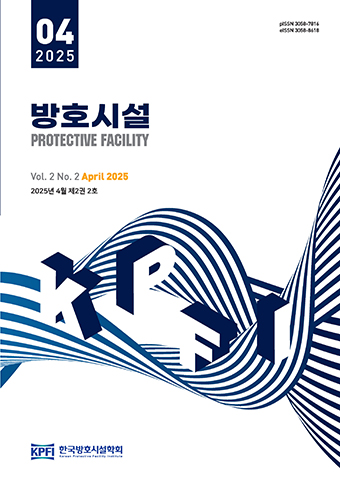 Protective Facility
Protective Facility






